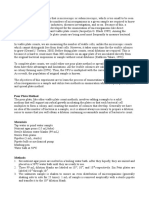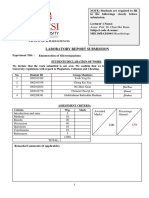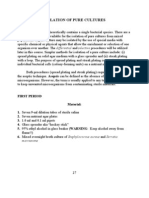0 ratings0% found this document useful (0 votes)
3 viewsCounting of Bacteria
Uploaded by
sruthikareddy7972Copyright
© © All Rights Reserved
Available Formats
Download as PDF, TXT or read online on Scribd
0 ratings0% found this document useful (0 votes)
3 viewsCounting of Bacteria
Uploaded by
sruthikareddy7972Copyright
© © All Rights Reserved
Available Formats
Download as PDF, TXT or read online on Scribd
You are on page 1/ 8
( Counting of bacteria -Total and Viable counting
techniques.)
➢ Bacterial growth can be determined by various technique,
based on based one or more of the following types of
measurements.
Cell number or cell count
Cell mass
Cell activity
Determination of cell number
➢ The following methods are used for determination of cell
number of bacteria
1. Direct microscopic count
2.Electronic enumeration of cell number
3.Plate count method
4.Membrane filtration method
1.Direct microscopic count
• It is direct method.
➢ In this method bacteria can be counted easily and accurately by
using Petroff Hausser counting chamber.
➢ This is a special slide accurately ruled in to squares that are 1/400
mm2 in area, a glass cove slip rest 1/50mm above the slide, so that
the volume over a square is 1/20,000 mm3cube.
➢ A suspension of unstained bacteria can be counted in this chamber.
by using a phase contrast microscope.
➢ Take suspension of bacteria to be counted and spread on the
surface of slide .
➢ Observe under microscope and count the bacteria.
Advantages
➢ This method is simple and rapid
➢ The morphology of the bacteria cab be observed, as they are
counted.
➢ Very dense suspension of bacteria can be counted, if they are
diluted appropriately.
Diadvantages
➢ The major disadvantages of this method is that it gives a total count
which includes both viable and non viable cells.
2.Electronic enumeration of cell number
➢ In this method an electronic instrument called electronic particle
counter or coulter counter is used to count the bacteria in sample.
➢ In this method, the bacterial susspension is placed in electronic
particle counter, with in which the bacteria are passed through a
tiny orifice (10 to 30 micro m in diameter). This orifice connects
the two components of the counter which contain an electrically
conductive solution.
➢ As each bacterium passes through the orifice, the electrical
resistance between the two compartments increases.
➢ This generate an electrical signal, which is automatically counted.
➢ One electrical signal equal to one bacteria.
➢ This instrument is capable of counting thousands of bacteria cells
in a few seconds
➢ This method is rapid, but the orifice tends to become clogged .
➢ The suspending fluid must be free from inanimate particles e.g.
dust.
Diadvantages
➢ The major disadvantages of this method is that it gives a total
count which includes both viable and non viable cells.
To determine the viable count of bacteria, we must use a technique
that allows viable cells to multiply, such as the plate count method or
the membrane count method are used
3.Plate count method
➢ This method is commonly used for enumeration of bacteria in
water, milk, food and in many other pharmaceutical substances.
➢ This method allows the determination of the number of cells that
will multiply under defined conditions.
➢ In this method, the bacterial suspension is first diluted in sterile
water.
➢ A measured quantity of the sample is introduced in to sterile
petriidish, after which the agar medium ( maintained in liquid state
at 45°C)) is added and thoroughly mixed by rotating the plate.
➢ When the medium solidifies, the organisms are trapped in the gel
and plate is incubated.
➢ Each bacterium grows, one organism gives rise to one colony
when bacterial suspension is homogenous.
➢ Various electronic techniques have been developed for the
counting of colonies.
➢ Colonies are also counted by illuminating them from below ( dark
field illumination),so that they are easily visible and a large
magnifying lens is used.
➢ The total number of bacterial cell per ml is obtained by
multiplying the number of colonies counted on plate with dilution
factor
Advantages
➢ Only viable cells are counted.
➢ It is very sensitive method, since very small number of organism
can be counted.
4.Membrane filtration method.
➢ This method follows the same principle as in a plate count method.
➢ In this method membrane filters or molecular filters with known porosity
is used.
➢ A diluted sample is filtered through membrane filter and the bacteria are
retained on the surface of membrane.
➢ The membrane with trapped bacteria is placed on culture medium
containing petri plate .
➢ The plates are incubated and count the colonies present on the surface of
membrane
This method has many advantages over the plate count.
➢ This method is useful in determining the number of bacteria present in a
large samples, when the number of bacteria are very less. E.g. the bacteria
in a large volume of air, water can be measured by this method
➢ Various types of bacteria can be detected by using selective media, dyes
and different conditions of growth.
You might also like
- Molecular Cell Biology 4th Edition HarveNo ratings yetMolecular Cell Biology 4th Edition Harve3 pages
- Microbiology Bacterial Growth by Jayashri Vidya 1No ratings yetMicrobiology Bacterial Growth by Jayashri Vidya 133 pages
- Lecture-12.Measurment Techniques.kfr (1)No ratings yetLecture-12.Measurment Techniques.kfr (1)39 pages
- Measurement of Bacterial Growth: Speaker Ratul Mukherjee Department of Microbiology, J.K.College, PuruliaNo ratings yetMeasurement of Bacterial Growth: Speaker Ratul Mukherjee Department of Microbiology, J.K.College, Purulia21 pages
- Enumeration of Bacteria by Different MethodNo ratings yetEnumeration of Bacteria by Different Method4 pages
- Techniques in Measuring Microbial GrowthNo ratings yetTechniques in Measuring Microbial Growth7 pages
- Microbiology 12 - Microbial Growth 2_Growth measurements, factors affectingNo ratings yetMicrobiology 12 - Microbial Growth 2_Growth measurements, factors affecting27 pages
- [Lab 4–Serial Dilution - agar Plate Procedure to Quantitate Viable Cells]No ratings yet[Lab 4–Serial Dilution - agar Plate Procedure to Quantitate Viable Cells]7 pages
- MCB 203 (Basic Techniques in Microbiology)No ratings yetMCB 203 (Basic Techniques in Microbiology)12 pages
- Isolation of Microorganism and EnumerationNo ratings yetIsolation of Microorganism and Enumeration13 pages
- Dilution Number of Colonies CFU ml-1 of Original Broth Culture 10No ratings yetDilution Number of Colonies CFU ml-1 of Original Broth Culture 102 pages
- Experiment 3 - Air, Water and Soil PollutionNo ratings yetExperiment 3 - Air, Water and Soil Pollution9 pages
- Serial Dilution - Agar Plate Procedure To Quantitate Viable CellsNo ratings yetSerial Dilution - Agar Plate Procedure To Quantitate Viable Cells12 pages
- Enumeration of Microorganisms: Microbiology BIOL 275No ratings yetEnumeration of Microorganisms: Microbiology BIOL 27510 pages
- Enumeration of Microorganisms: Microbiology BIOL 275No ratings yetEnumeration of Microorganisms: Microbiology BIOL 27510 pages
- Chapter 5 - Basic Techniques in Food Microbiology100% (1)Chapter 5 - Basic Techniques in Food Microbiology54 pages
- Estimation or Determination of Microbial GrowthNo ratings yetEstimation or Determination of Microbial Growth6 pages
- LABORATORY MANUAL FOR A MINI PROJECT: MSCB 1113 BIOCHEMISTRY & MICROBIAL PHYSIOLOGYFrom EverandLABORATORY MANUAL FOR A MINI PROJECT: MSCB 1113 BIOCHEMISTRY & MICROBIAL PHYSIOLOGYNo ratings yet
- ICAR E-course Plant Propagation and Nursery Manage_250129_164101No ratings yetICAR E-course Plant Propagation and Nursery Manage_250129_16410162 pages
- Harper 2010. Lamp-color Xyllela fastidiosa.No ratings yetHarper 2010. Lamp-color Xyllela fastidiosa.8 pages
- Organ Specialization in Fuel MetabolismNo ratings yetOrgan Specialization in Fuel Metabolism20 pages
- Cell Signaling Poster and Presentation RubricNo ratings yetCell Signaling Poster and Presentation Rubric3 pages
- Mr. Bioengineer: Skills Overview Work ExperienceNo ratings yetMr. Bioengineer: Skills Overview Work Experience2 pages
- Genetically Modified Organisms (Gmos) Module 1: Selective BreedingNo ratings yetGenetically Modified Organisms (Gmos) Module 1: Selective Breeding4 pages
- New Variant Creutzfeld-Jakod Dse: Presented By: Janilla Dawn O. IfurungNo ratings yetNew Variant Creutzfeld-Jakod Dse: Presented By: Janilla Dawn O. Ifurung20 pages
- You Et Al 2022 Metagenomic Features of Traditional Fermented Milk ProductsNo ratings yetYou Et Al 2022 Metagenomic Features of Traditional Fermented Milk Products11 pages
- Fundamentals of Systems Biology From Synthetic Circuits to Whole cell Models 1st Edition Markus W. Covert - The full ebook version is available, download now to explore100% (2)Fundamentals of Systems Biology From Synthetic Circuits to Whole cell Models 1st Edition Markus W. Covert - The full ebook version is available, download now to explore80 pages
- Review Questions For Genetics and Heredity Test100% (1)Review Questions For Genetics and Heredity Test6 pages
- Prepared & Presented By: Juris Justin M. Tovera100% (1)Prepared & Presented By: Juris Justin M. Tovera73 pages
- LECTURE 4-Microbiological methods-S201920I - NMMNo ratings yetLECTURE 4-Microbiological methods-S201920I - NMM42 pages
- Genetic Diversity of Bosnian and Herzegovinian Autochthonous Dog Breed Bosnian Broken Haired Hound-BarakNo ratings yetGenetic Diversity of Bosnian and Herzegovinian Autochthonous Dog Breed Bosnian Broken Haired Hound-Barak15 pages
- Class- 11 Neet Test Series Syllabus 2025-2026No ratings yetClass- 11 Neet Test Series Syllabus 2025-20261 page

























































































